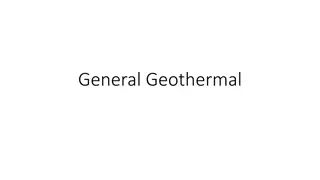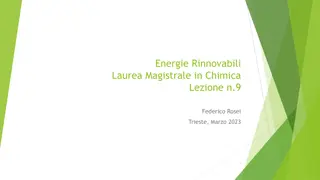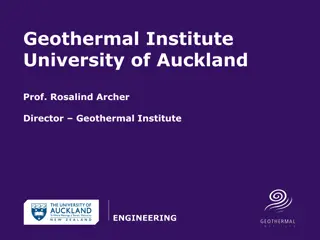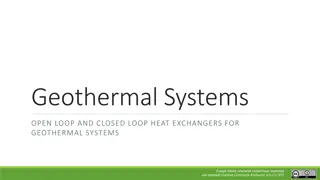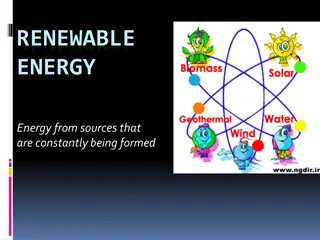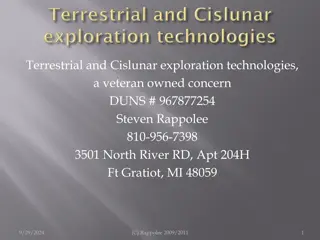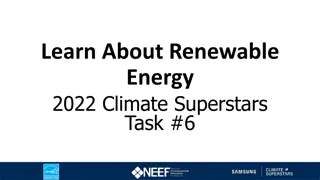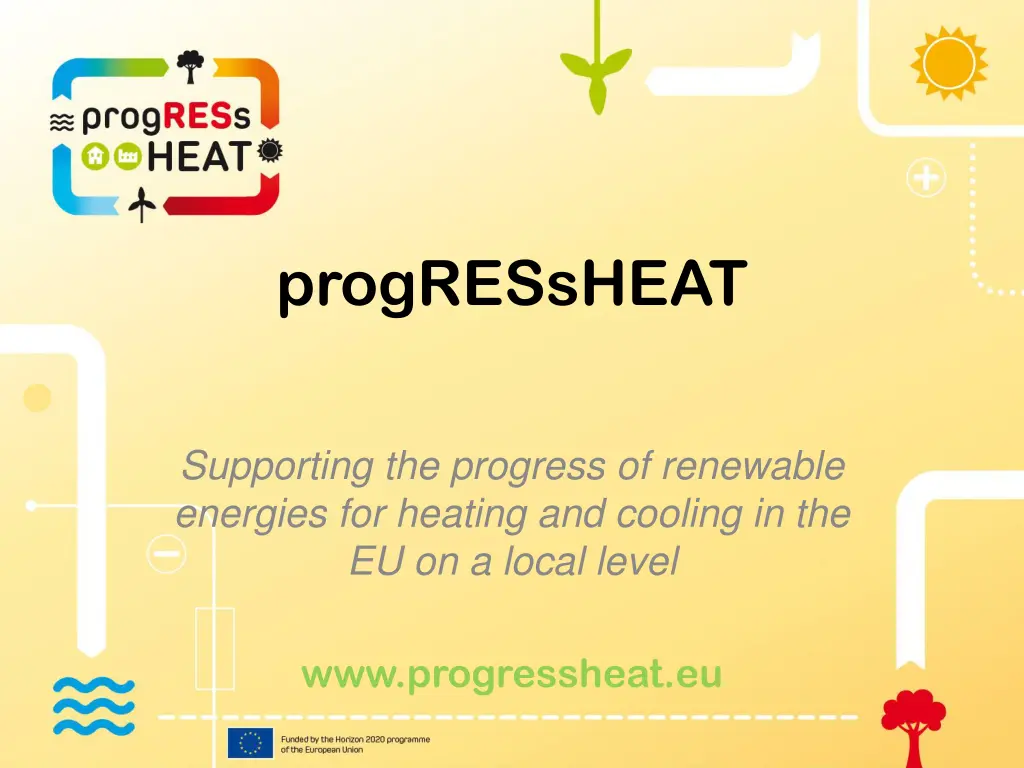
Geothermal Energy: Harnessing the Earth's Thermal Resources
Learn about geothermal energy and its various applications for heating, cooling, and electricity generation. Discover the different types of geothermal energy, including deep geothermal energy for power generation and near-surface geothermal energy for heating buildings. Explore the advantages, disadvantages, and investment costs associated with geothermal energy projects. Dive into the technical systems utilized in deep geothermal energy, such as petro-thermal and hydrothermal systems. Understand the temperature ranges of the Earth for direct and indirect thermal energy utilization. Join the movement towards sustainable energy solutions with geothermal resources.
Download Presentation

Please find below an Image/Link to download the presentation.
The content on the website is provided AS IS for your information and personal use only. It may not be sold, licensed, or shared on other websites without obtaining consent from the author. If you encounter any issues during the download, it is possible that the publisher has removed the file from their server.
You are allowed to download the files provided on this website for personal or commercial use, subject to the condition that they are used lawfully. All files are the property of their respective owners.
The content on the website is provided AS IS for your information and personal use only. It may not be sold, licensed, or shared on other websites without obtaining consent from the author.
E N D
Presentation Transcript
progRESsHEAT Supporting the progress of renewable energies for heating and cooling in the EU on a local level www.progressheat.eu
Geothermal Energy Capacity Building Material
Geothermal energy Index Introduction Types of geothermal energy Deep geothermal energy Near surface geothermal energy Advantages / Disadvantages Investment costs (example)
Geothermal energy Introduction Geothermal energy is the energy contained in the ground This thermal energy can be used for different purposes Heating Cooling Electricity generation Geothermal energy can be split into Deep geothermal energy (depth up to 400m) Near surface geothermal energy (depth above 400m)
Geothermal energy Introduction Temperature of the earth Direct use Using the thermal energy directly for providing heat -50 500 C 450 1400 C 1400 3000 C Indirect use Using the thermal energy for generating electricity or for cooling 2900 4000 C 4000 6700 C Source: Energy Engineers GmbH
Geothermal energy Types of geothermal energy Deep geothermal energy depth of heat source is > 400m primarily used in large power plants for generating electricity (and heat) high upfront costs due to large facilities as well as drilling costs Near surface geothermal energy depth of heat source is < 400m primarily used for heating and cooling of buildings investment costs smaller than for deep geothermal energy plants
Geothermal energy Deep geothermal energy In general: Used to generate electricity and heat for large district heating networks Drilling deeper than 400 m; maximum depth currently around 7.000 m Direct use of hot water bearing strata found at great depths Thermal energy used directly in the heat exchanger No heat pump needed Technical System Types: Petro-thermal systems Hydrothermal systems Deep borehole heat exchangers
Geothermal energy Petro-thermal systems Use of geothermal energy contained in deep rock strata (between 3.000 and 6.000 m), in which no or insufficient natural water is present Deep boreholes used to circulate water through a system of cracks and fissures in the rock created by a controlled process Natural thermal lifting forces of the hot water facilitates the circulation The hot water is conveyed to the surface through an extraction borehole and used as steam to drive a turbine for electricity generation, excess heat from the turbine or direct steam from the borehole is fed into the heating grid The Kalina Cycle and the Organic Rankine Cycle (ORC) are suitable for using lower temperature levels of 120 200 C for generating electricity
Geothermal energy Hydrothermal systems Requirement: Existence of stone layers containing relevant amounts of water Two drillings in a depth of 2.000 4.000 m necessary (supply and reinjection holes) The hot water flows through the supply borehole into the heat exchanger. After that the cooled water flows trough the injection hole back to the aquifer To sustainably operate the reservoir, the cooled thermal water is re-injected The hot water can be used to generate electricity in a turbine or be directly used in heating grids Source: CC BY 3.0
Geothermal energy Near surface geothermal energy In general: Heat contained in the upper layers of the earth up to a maximum depth of 400 m are used Suitable for heating and cooling of buildings Average earth temperatures in the first 100 meters is between 7 to 12 C Systems: Heating: Heat pumps are used to elevate the temperature of the circulated water to the temperatures required in the building Cooling: The temperatures of the circulated water can be used directly without a heat pump, if this is sufficient for providing the necessary cooling capacities. If the temperatures are not sufficient to provide the necessary cooling capacities, a heat pump is used to provide the remaining cooling capacity
Geothermal energy Near surface geothermal energy Borehole heat exchangers Geothermal heat collectors Source: CC BY-SA 3.0, EnergieAgentur.NRW Source: CC BY-SA 3.0, EnergieAgentur.NRW
Geothermal energy Disadvantages Advantages Not all locations provide necessary potentials Often geothermal potential is not near cities High upfront costs Risk that temperatures in the boreholes are less than expected Energy supply for the heat pumps is vital, i.e. no heat without electricity May Release Harmful Gases Unclear research results regarding earth geological movements, leads to public discussion and lower acceptance ratings thus citizen involvement is vital No pollution and emissions in operation No waste or generation of by-products Can often be used directly Significant savings on utility bills on the long term Long-term stability of heat flow Multiple uses (cooling in summer & heating in winter) Geothermal power plants are space- saving and help in protecting natural environment Independent of the weather conditions No storage or grid necessary when off- grid
Geothermal energy Range of investment costs Prices range from 30 70 / m f. e. 60 /m ; 800 1.200 /kW Investment costs much higher than a conventional heating system. But the maintenance costs are significantly lower. Source: EnergieAgentur.NRW Heat pump capacity Sufficient drill depth Recommended drill depth Optimal drill depth 5 kW ~ 80 m / 4500-5000 ~ 90 m / 5000-5500 ~ 100 m / 5500-6000 8 kW ~ 130 m / 7500-8000 ~ 140 m / 8000-8500 ~ 150 m / 9000-9500 11 kW ~ 180m / 1050-11000 ~ 200 m / 12000-12500 ~ 220 m /13000-13500 14 kW ~ 240 m / 13500-14000 ~ 260 m / 15000-15500 ~ 280 m / 16500-17000 23 kW ~ 370 m / 22000-22500 ~ 410 m / 24000-24500 ~ 450 m / 26500-27000 30 kW ~ 490 m / 28500-29000 ~ 540 m / 31500-32000 ~ 590 m / 34500-35000 37 kW ~ 610 m / 35500-36000 ~ 670 m / 39500-40000 ~ 730 m /43000-43500
Geothermal energy Investment costs (example) Preparation of a borehole heat exchanger (Erdw rmesonde) Construction of the building site: Drilling work, sensor installation, pressing in the borehole: Surcharge for thermal improved grouting material: Permit fees (district administration): Permit fees mining law (deeper than 100m): Removal of drill cuttings: Civil engineering work: Frost protection, brine, heat carrier: Distribution shaft: Probe extension and distributor: Shutoff for the house connection: 250-750 38-42 /m 2-5 /m 150-300 80 140-220 /container 30-50 /m 1,20-1,59 /l 300 590 160 The costs vary depending on the size. Source: EnergieAgentur.NRW
Thank you for your attention! Supporting the progress of renewable energies for heating and cooling in the EU on a local level www.progressheat.eu




